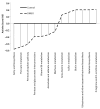Central Carbon Metabolism in Candida albicans Biofilms Is Altered by Dimethyl Sulfoxide
- PMID: 38786692
- PMCID: PMC11121877
- DOI: 10.3390/jof10050337
Central Carbon Metabolism in Candida albicans Biofilms Is Altered by Dimethyl Sulfoxide
Abstract
The effect of dimethyl sulfoxide (DMSO) on fungal metabolism has not been well studied. This study aimed to evaluate, by metabolomics, the impact of DMSO on the central carbon metabolism of Candida albicans. Biofilms of C. albicans SC5314 were grown on paper discs, using minimum mineral (MM) medium, in a dynamic continuous flow system. The two experimental conditions were control and 0.03% DMSO (v/v). After 72 h of incubation (37 °C), the biofilms were collected and the metabolites were extracted. The extracted metabolites were subjected to gas chromatography-mass spectrometry (GC/MS). The experiment was conducted using five replicates on three independent occasions. The GC/MS analysis identified 88 compounds. Among the 88 compounds, the levels of 27 compounds were markedly different between the two groups. The DMSO group exhibited enhanced levels of putrescine and glutathione and decreased levels of methionine and lysine. Additionally, the DMSO group exhibited alterations in 13 metabolic pathways involved in primary and secondary cellular metabolism. Among the 13 altered pathways, seven were downregulated and six were upregulated in the DMSO group. These results indicated a differential intracellular metabolic profile between the untreated and DMSO-treated biofilms. Hence, DMSO was demonstrated to affect the metabolic pathways of C. albicans. These results suggest that DMSO may influence the results of laboratory tests when it is used as a solvent. Hence, the use of DMSO as a solvent must be carefully considered in drug research, as the effect of the researched drugs may not be reliably translated into clinical practice.
Keywords: Candida albicans; biofilm; dimethyl sulfoxide; metabolic pathways; metabolomics.
Conflict of interest statement
The authors declare no conflict of interest.
Figures





Similar articles
-
GC-MS-Based Metabolomics Study of Single- and Dual-Species Biofilms of Candida albicans and Klebsiella pneumoniae.Int J Mol Sci. 2021 Mar 28;22(7):3496. doi: 10.3390/ijms22073496. Int J Mol Sci. 2021. PMID: 33800643 Free PMC article.
-
A metabolomic analysis on the toxicological effects of the universal solvent, dimethyl sulfoxide.Comp Biochem Physiol C Toxicol Pharmacol. 2025 Jan;287:110073. doi: 10.1016/j.cbpc.2024.110073. Epub 2024 Nov 8. Comp Biochem Physiol C Toxicol Pharmacol. 2025. PMID: 39522855
-
Effect of curcumin-encapsulated Pluronic® F-127 over duo-species biofilm of Streptococcus mutans and Candida albicans.Lasers Med Sci. 2022 Apr;37(3):1775-1786. doi: 10.1007/s10103-021-03432-9. Epub 2021 Oct 19. Lasers Med Sci. 2022. PMID: 34664132
-
Dimethyl sulfoxide (DMSO) inhibits the germination of Candida albicans and the arthrospores of Trichophyton mentagrophytes.Nihon Ishinkin Gakkai Zasshi. 2008;49(2):125-8. doi: 10.3314/jjmm.49.125. Nihon Ishinkin Gakkai Zasshi. 2008. PMID: 18451594
-
LC-MS analysis reveals biological and metabolic processes essential for Candida albicans biofilm growth.Microb Pathog. 2021 Mar;152:104614. doi: 10.1016/j.micpath.2020.104614. Epub 2020 Nov 14. Microb Pathog. 2021. PMID: 33202254
References
-
- CDC—Centers for Disease Controls and Prevention . Antibiotic Resistance Threats in the United States: Drug-Resistant Candida Species. U.S. Department of Health and Human Services; Washington, DC, USA: 2019. [(accessed on 10 December 2021)]. Available online: https://www.cdc.gov/drugresistance/pdf/threats-report/2019-ar-threats-re....
-
- Low A., Gavriilidis G., Larke N., B.-Lajoie M.-R., Drouin O., Stover J., Muhe L., Easterbrook P. Incidence of opportunistic infections and the impact of antiretroviral therapy among hiv-infected adults in low- and middle-income countries: A systematic review and meta-analysis. Clin. Infect. Dis. 2016;62:1595–1603. doi: 10.1093/cid/ciw125. - DOI - PMC - PubMed
-
- CLSI—Clinical and Laboratory Standards Institute . Reference Method for Broth Dilution Antifungal Susceptibility Testing of Yeasts; Approved Standard. 3rd ed. Volume 14 Clinical and Laboratory Standards Institute; Wayne, PA, USA: 2008. CLSI Document M27-A3.
Grants and funding
LinkOut - more resources
Full Text Sources
Miscellaneous

